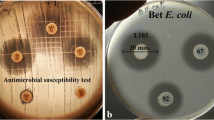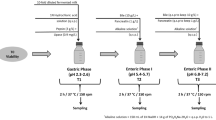Abstract
The overuse and abuse of antibiotics in animal husbandry is an ongoing problem. While probiotics could be an alternative, their effectiveness, stability and production cost are key factors that need to be addressed first. This study used a mixed culture of Bifidobacterium bifidum, Clostridium butyricum, Bacillus subtilis and Bacillus licheniformis on a simple and inexpensive solid-state medium generated by pouring a liquid MRS medium, which was designed to favor the dense growth of lactobacilli, onto wheat bran at a ratio of 1:2 by weight. Using this method, we achieved a very high number of live bacteria (NLB), at 3.93 × 1014 CFU/g, without the need for expensive anaerobic equipment. The mixed culture thus achieved striking results that were up to 10,000 times better than the pure culture and did not require special anaerobic equipment. A real-time PCR analysis demonstrated that the shares of the four strains in the mixed culture probiotics (MCPs) were 2, 17, 46, and 35%, respectively, which indicates that the fermentation product contained an uneven distribution of the four probiotic target bacteria. The MCPs possessed good storage stability at room temperature, and the NLB was greater than 106 CFU/g after 30 days at 25°C, which made it easier to transport and store. They also demonstrated good stability in artificial digestion fluids, with an NLB of over 1012 CFU/g after sequential treatments, which enabled them to maintain effectiveness in the animal gastrointestinal tract. Finally, the MCPs were fed to the mealworms (Tenebrio molitor) and raccoon dogs (Nyctereutes procyonoides) in order to test their effectiveness, and the growth rates of both significantly improved with the MCPs feeding. This study thus demonstrated that culturing MCPs on a solid-state medium is an efficient method to affordably produce probiotic feed additives that can improve the performance of very physiologically different animals, such as the mealworm and raccoon dog, which indicates their potential for very wide applicability.
Similar content being viewed by others
References
Chen, Y. and W. Schwack (2014) High-performance thin-layer chromatography screening of multi class antibiotics in animal food by bioluminescent bioautography and electrospray ionization mass spectrometry. J. Chromatogr. A. 1356: 249–257.
Duncan, S. H. and H. J. Flint (2013) Probiotics and prebiotics and health in ageing populations. Maturitas 75: 44–50.
Wassenaar, T. M. and G. Klein (2008) Safety aspects and implications of regulation of probiotic bacteria in food and food supplements. J. Food Protect. 71: 1734–1741.
Sugahara, H., T. Odamaki, S. Fukuda, T. Kato, J. Z. Xiao, and F. Abe (2015) Probiotic Bifidobacterium longum alters gut luminal metabolism through modification of the gut microbial community. Sci. Rep. 5: 13548.
de Vries, W. and A. H. Stouthamer (1968) Fermentation of glucose, lactose, galactose, mannitol, and xylose by bifidobacteria. J. Bacteriol. 96: 472–478.
de Roos, N. M. and M. B. Katan (2000) Effects of probiotic bacteria on diarrhea, lipid metabolism, and carcinogenesis: A review of papers published between 1988 and 1998. Am. J. Clin. Nutr. 71: 405–411.
Turroni, F., E. Foroni, P. Pizzetti, V. Giubellini, A. Ribbera, and P. Merusi (2009) Exploring the diversity of the bifidobacterial population in the human intestinal tract. Appl. Environ. Microb. 75: 1534–1545.
Meng, Q. W., L. Yan, X. Ao, T. X. Zhou, J. P. Wang, and J. H. Lee (2010) Influence of probiotics in different energy and nutrient density diets on growth performance, nutrient digestibility, meat quality, and blood characteristics in growing-finishing pigs. J. Anim. Sci. 88: 3320–3326.
Guo X., D. Li, W. Lu, X. Piao, and X. Chen (2006) Screening of Bacillus strains as potential probiotics and subsequent confirmation of the in vivo effectiveness of Bacillus subtilis MA139 in pigs. Antonie Van Leeuwenhoek. 90: 139–146.
Boyadzhieva, I. P., M. Atanasova, and E. Emanuilova (2010) A novel, thermostable manganese-containing superoxide dismutase from Bacillus licheniformis. Biotechnol. Lett. 32: 1893–1896.
Lacroix, C. and S. Yildirim (2007) Fermentation technologies for the production of probiotics with high viability and functionality. Curr. Opin. Biotechnol. 18: 176–183.
Parekh, S., V. A. Vinci, and R. J. Strobel (2000) Improvement of microbial strains and fermentation processes. Appl. Microbiol. Biotechnol. 54: 287–301.
Meng, X., Q. Wu, L. Wang, D. Wang, L. Chen, and Y. Xu (2015) Improving flavor metabolism of Saccharomyces cerevisiae by mixed culture with Bacillus licheniformis for Chinese Maotai-flavor liquor making. J. Ind. Microbiol. Biotechnol. 42: 1601–1608.
Liu, C., X. T. Lv, W. X. Zhu, H. Y. Qu, Y. X. Gao, and B. Y. Guo (2013) Enantioselective bioaccumulation of diniconazole in Tenebrio molitor larvae. Chiral. 25: 917–922.
Gulevsky, A. K., L. I. Relina, and Y. A. Grishchenkova (2006) Variations of the antioxidant system during development of the cold-tolerant beetle, Tenebrio molitor. Cryo. Lett. 27: 283–290.
Baruzzi, F., P. Poltronieri, G. M. Quero, M. Morea, and L. Morelli (2011) An in vitro protocol for direct isolation of potential probiotic lactobacilli from raw bovine milk and traditional fermented milks. Appl. Microbiol. Biotechnol. 90: 331–342.
Zhang, F., X. Y. Li, H. J. Park, and M. Zhao (2013) Effect of microencapsulation methods on the survival of freeze-dried Bifidobacterium bifidum. J. Microencapsul. 30: 511–518.
Trabelsi, I., W. Bejar, D. Ayadi, H. Chouayekh, R. Kammoun, and S. Bejar (2013) Encapsulation in alginate and alginate coated-chitosan improved the survival of newly probiotic in oxgall and gastric juice. Int. J. Biol. Macromol. 61: 36–42.
Ortakci, F. and S. Sert (2012) Stability of free and encapsulated Lactobacillus acidophilus ATCC 4356 in yogurt and in an artificial human gastric digestion system. J. Dairy Sci. 95: 6918–6925.
Awolu, O. O., O. S. Omoba, O. Olawoye, and M. Dairo (2017) Optimization of production and quality evaluation of maizebased snack supplemented with soybean and tiger-nut (Cyperus esculenta) flour. Food Sci. Nutr. 5: 3–13.
Raji, A. O., R. Akinoso, and M. O. Raji (2016) Effect of freezethaw cycles on the nutritional quality of some selected Nigerian soups. Food Sci. Nutr. 4: 163–180.
Qiu, C., P. Shi, S. Xiao, and L. Sun (2017) Effects of pH and substrate concentrations on dark fermentative biohydrogen production from xylose by extreme thermophilic mixed culture. World J. Microbiol. Biotechnol. 33: 7.
Cinque, B., C. La Torre, F. Lombardi, P. Palumbo, Z. Evtoski, and S. J. Santini (2017) VSL#3 probiotic differently influence IEC-6 intestinal epithelial cell status and function. J. Cell Physiol. 232: 3530–3539.
Martin Del Campo, M., R. M. Camacho, J. C. Mateos-Diaz, M. Muller-Santos, J. Cordova, and J. A. Rodriguez (2015) Solidstate fermentation as a potential technique for esterase/lipase production by halophilic archaea. Extremophil. 19: 1121–1132.
Zhang, Y. R., H. R. Xiong, and X. H. Guo (2014) Enhanced viability of Lactobacillus reuteri for probiotics production in mixed solid-state fermentation in the presence of Bacillus subtilis. Folia Microbiol. 59: 31–36.
Chatzifragkou, A., S. Papanikolaou, N. Kopsahelis, V. Kachrimanidou, M. P. Dorado, and A. A. Koutinas (2014) Biorefinery development through utilization of biodiesel industry by-products as sole fermentation feedstock for 1,3-propanediol production. Bioresour. Technol. 159: 167–175.
Gueimonde, M. and B. Sanchez (2012) Enhancing probiotic stability in industrial processes. Microb. Ecol. Health Dis. 23.
Forkus, B., S. Ritter, M. Vlysidis, K. Geldart, and Y. N. Kaznessis (2017) Antimicrobial probiotics reduce salmonella enterica in turkey gastrointestinal tracts. Sci. Rep. 7: 40695.
Zhu, J. Y., S. Z. Ze, D. W. Stanley, and B. Yang (2014) Parasitization by Scleroderma guani influences expression of superoxide dismutase genes in Tenebrio molitor. Arch. Insect Biochem. Physiol. 87: 40–52.
Dhama, K., S. K. Latheef, A. K. Munjal, R. Khandia, H. Abdul Samad, and H. M. Iqbal (2016) Probiotics in curing allergic and inflammatory Conditions - research progress and futuristic vision. Recent Pat. Inflamm. Allergy Drug Discov. 10.
Stefano, G. B., J. Samuel, and R. M. Kream (2017) Antibiotics may trigger mitochondrial dysfunction inducing psychiatric disorders. Med. Sci. Monit. 23: 101–106.
Author information
Authors and Affiliations
Corresponding author
Electronic supplementary material
Rights and permissions
About this article
Cite this article
Zhong, J., Zhang, F., Peng, Y. et al. Mixed culture of probiotics on a solid-state medium: An efficient method to produce an affordable probiotic feed additive. Biotechnol Bioproc E 22, 758–766 (2017). https://doi.org/10.1007/s12257-017-0038-y
Received:
Revised:
Accepted:
Published:
Issue Date:
DOI: https://doi.org/10.1007/s12257-017-0038-y




